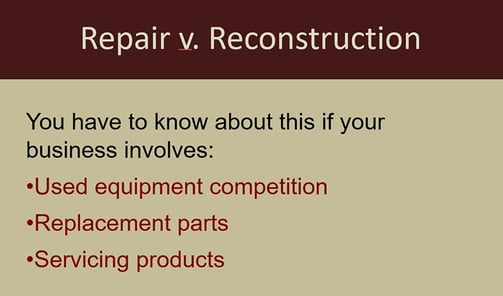Pitfalls under the Repair v Reconstruction Doctrine

The repair v. reconstruction doctrine (RRD) also limits patent scope. You are significantly impacted by the RRD if you sell patented items, such as capital equipment, for which there is a sizeable used equipment or repair markets. You also are significantly impacted by the RRD if you generate a substantial portion of your revenues from replacement parts or service for previously sold patented items. One consequence is that your patent rights might protect you very well in the new sales market, but not at all or poorly in the used market. Your replacement parts business might be vulnerable, too, unless key features of key replacement parts are themselves protected by patents.
The RRD divides refurbishment activity into two main categories: repair and reconstruction. A refurbisher is permitted (i.e., is impliedly licensed) to “repair” a patented item but not to “reconstruct” a patented item.
Repair means that anyone who buys a patented item, or licenses it without applicable license restrictions, has an implied right to repair that item and keep it in proper working order. A refurbisher can repair patented items without violating patent rights that protect the patented item.
In contrast to “repair” rights, a refurbisher has no rights under the RRD to “reconstruct” a patented item. Generally, reconstruction, not repair, occurs if the refurbisher reconstructs a totally worn or spent product to make it operable again,1 or reconstructs the item so extensively that it is transformed into a new article.
 A patent owner may have patent rights that cover replacement parts and/or refurbishment methods. Under current case law, the RRD does not authorize a refurbisher to undertake refurbishment activities that involve such patented replacement parts or refurbishment methods. In RRD parlance, such refurbishment constitutes impermissible reconstruction, not repair. This means that a patent owner can obligate you to buy patented replacement parts and patented services only from authorized sources. Interestingly, this also highlights important differences between patents that protect entire products and patents that protect only components. Patents that protect key components and repair methods are very important to protect against refurbishment activity in the used equipment market and might also help protect new sales; patents more broadly protecting entire systems are mainly useful for new sales and are much less potent in the used market.
A patent owner may have patent rights that cover replacement parts and/or refurbishment methods. Under current case law, the RRD does not authorize a refurbisher to undertake refurbishment activities that involve such patented replacement parts or refurbishment methods. In RRD parlance, such refurbishment constitutes impermissible reconstruction, not repair. This means that a patent owner can obligate you to buy patented replacement parts and patented services only from authorized sources. Interestingly, this also highlights important differences between patents that protect entire products and patents that protect only components. Patents that protect key components and repair methods are very important to protect against refurbishment activity in the used equipment market and might also help protect new sales; patents more broadly protecting entire systems are mainly useful for new sales and are much less potent in the used market.
Overzealous patent owners may try to tie sales of patented items with the sale of unpatented items or services. For example, that new, patented car you just bought from Acme Motors might need an oil change in a few months. Can Acme obligate you to buy unpatented oil change services from them as a condition of their selling the car to you? Apart from the antitrust implications of this tie, the RRD would not permit the tie either. Under the RRD, you have a right to repair your car using unpatented parts and services.
The patent owner cannot leverage patent rights to force you to buy its other unpatented items or services, but force is key. The patent owner can still offer such unpatented items and services to you if undue patent leverage is absent.
To evaluate whether refurbishment activities are proper, understanding the definitions of “repair” and “reconstruction” is crucial. You may think that it is relatively easy to categorize competitive activities as either repair or reconstruction. In some circumstances, it arguably is easy. But in many commercially important scenarios, it is difficult to determine if conduct is repair or reconstruction. The distinction between repair and reconstruction is grey in many fact patterns. Patent owners and refurbishers litigate over the RRD with some frequency.
Trying to predict an outcome can be a minefield for both parties. A patent owner risks violating the antitrust laws via conduct that unduly attempts to restrict repair activities or otherwise overextend its patent rights, which can have criminal and civil ramifications.2
An aggressive refurbisher who falls on the reconstruction side of the fence risks exposure to damages for patent, trademark, trade secret, copyright, contract, or other rights.
In most instances, patented items are sold or licensed. Restrictions on sold goods are more likely to implicate anti-competitive laws and/or be unenforceable. A patent owner can use more restrictions in a license, but even these can be troublesome. Outright restrictions on repair likely would be disfavored as would be provisions that fix prices, mandate that repairs can be performed only by authorized sources, set up boycotts, tie in, tie out, mandate overly broad grant backs of rights, restrict competitive development, etc.
Currently, courts have a strong bias that favors repair over reconstruction. A substantial majority of published decisions reach holdings of repair, not reconstruction. This does not mean that reconstruction is a dead letter, though. The most egregious, clear-cut cases might never make it to trial or be appealed. It is fair to presume that the reported trial and appellate decisions tend to involve close cases. Consequently, the bias for repair in the case law means that repair tends to be favored in close cases, not all cases.
Certain fact patterns are common, some of which, and their typical outcomes, are listed in the following table:
|
Take out, clean, and replace a part. |
Almost always repair: |
|
Replace a patented part with another patented part |
Almost always reconstruction. |
|
Replace a patented part with an unpatented part with same or different functionality |
Likely repair, but could be reconstruction depending upon claim scope |
|
Replace a missing part. |
Some cases say this is reconstruction. |
|
Early replacement of a part |
Repair, unless another category is applicable |
|
Replace an unpatented part with an unpatented part |
Almost always repair |
|
Both new machine and old machine exist |
Almost always reconstruction. |
|
Old machine discarded after new machine put together. |
Almost always reconstruction. |
|
Old machine has worn out completely and new machine put together in framework of old machine |
Likely to be reconstruction. But see Jazz Photo Corp. v. ITC, 264 F3d 1094, 59 USPQ2d 1907 (Fed. Cir. 2001) |
|
New functionality is incorporated into old machine by replacing some components with new ones |
Can be repair or reconstruction, but trend seems to favor repair |
|
New functionality is incorporated into old machine by adding some components |
Likely to be reconstruction, but could be repair if such as if customization is encouraged by patentee |
|
Disassemble a machine, clean and service the parts, and reassemble the machine |
Almost always repair: |
|
Disassemble several machines, and then rebuild the best parts into fewer machines |
Likely to be repair. |
1 But see Jazz Photo Corp. v. ITC, 264 F.3d 1094, 59 USPQ2d 1907 (Fed. Cir. 2001)(repair, not reconstruction, occurred even with extensive refurbishment of totally spent, single use cameras).
2 United States v. Univis Lens Co., 316 U.S. 241, 53 USPQ 404 (1942) is a good example. That case involved an enforcement action against an allegedly overzealous patent owner who overextended patent rights to fix prices.
